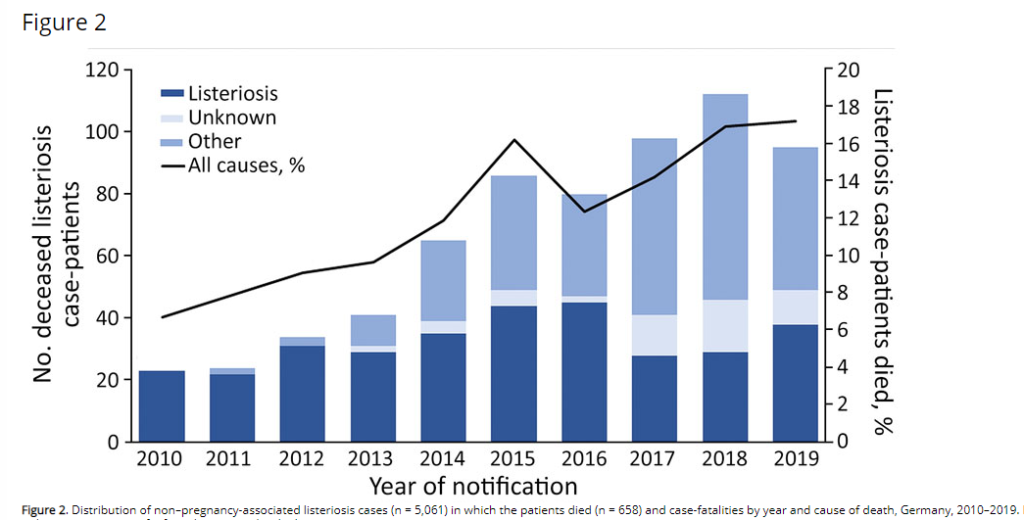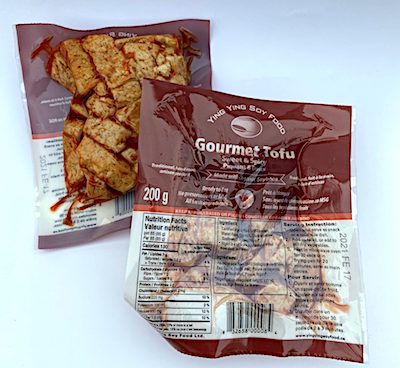Ten-year surveillance data (2010-2019) for the mandatory notification data about invasive listeriosis cases in Germany was reported in Emerging Infectious disease (Wilking et al., Emerging Infectious Disease Volume 27, Number 9, September 2021). A total of 5,576 listeriosis cases were reported. The case fatality rate was 13% in non-pregnancy cases. Most fatalities were in adults 65+. The case-fatality rate for Germany in this study is lower than that for Europe overall, 15.6%, and for the USA, 21%. The lowest annual incidence was in 2011 (0.41/100,000 residents) and the highest in 2017 (0.93/100,000 residents). The average for 2010–2019 was 0.69/100,000 residents. A steady increase in cases was seen during 2011–2017, but the incidence in 2019 was lower than in previous years. Exceptionally high numbers were reported in the third quarters of 2016, 2017, and 2018. Successfully identifying and controlling large outbreaks, especially after whole-genome sequencing-based surveillance was introduced, might explain why the trend in increases ended after 2017. Overall, listeriosis incidence in Germany is higher than in all neighboring countries except Denmark. @ https://wwwnc.cdc.gov/eid/article/27/9/21-0068_article
ruth
Invasive Listeriosis, Germany, 2010–2019
The CFIA reported that Ying Ying Soy Food Ltd., a Mississauga, Ontario establishment, recalls batch/lots of Ying Ying Soy Food branded Sweet & Spicy Tofu products from the Canadian marketplace due to suspected Salmonella contamination. The recalled product was sold in 500-gram packages. The Ying Ying Soy Food branded Sweet & Spicy Tofu products were marketed, distributed, and sold in Nova Scotia, Ontario, Quebec, Newfoundland, and Labrador. @ https://healthycanadians.gc.ca/recall-alert-rappel-avis/inspection/2021/76283r-eng.php
Notification for Ying Ying Soy Food brand Sweet & Spicy Tofu recalled due to Salmonella
ruth
The FDA issued a corporate-wide warning letter to Midwestern Pet Foods, Inc. because the FDA investigation revealed that their manufacturing plants violate the Federal Food, Drug, and Cosmetic Acts, which were shared across multiple plants. The violations were associated with the illness or death of hundreds of pets who had eaten the company’s dry dog food. Samples of dog food were found to contain high levels of aflatoxin. They must implement a robust hazard analysis and risk-based preventive controls program. The initial inspection of Midwestern’s Chickasha, Oklahoma plant was triggered by reports of illness or death in dogs that had eaten SPORTMiX brand dry dog food manufactured by Midwestern. Samples of SPORTMiX were later found to contain aflatoxin levels as high as 558 parts per billion (ppb). The FDA considers pet food to be adulterated if it contains more than 20 ppb of aflatoxin. In January, the company voluntarily recalled these products and all corn-containing pet foods manufactured at its Chickasha plant. Midwestern recalled pet food manufactured at its Monmouth, Illinois plant after samples tested positive for Salmonella in March. The FDA found that Midwestern’s food safety program appears inadequate to minimize or prevent Salmonella in its pet food significantly. As of August 9, the FDA is aware of more than 130 pet deaths and more than 220 pet illnesses linked to eating brands of pet food manufactured by Midwestern. Not all of these cases have been confirmed as aflatoxin poisoning through laboratory testing or veterinary record review. The FDA has requested a written response from the company within 15 working days stating the specific steps to correct any violations.@ https://www.fda.gov/news-events/press-announcements/fda-brief-fda-issues-corporate-wide-warning-letter-company-associated-contaminated-pet-food-hundreds?utm_medium=email&utm_source=govdelivery
The FDA has issued a corporate-wide warning letter to Midwestern Pet Foods, Inc.
ruth
The FDA reported that since July 21, 2021, additional cases have been identified in this outbreak, and this investigation was reopened. At least one ill person consumed shrimp that were not a part of the Avanti Frozen Foods of India’s initial recall. Due to this new information, on August 10, 2021, the FDA asked the firm to expand its initial recall to prevent additional illnesses. On August 13, 2021, Avanti Frozen Foods of India expanded its recall of frozen cooked shrimp to include frozen cooked shrimp products imported into the U.S. from November 2020 to May 2021. Since Avanti Frozen Foods expanded its recall, downstream recalls have been initiated for sushi products containing recalled shrimp sold in California. The current recall includes the following brands: 365, 265, AHOLD, BIG RIVER, CENSEA, CHICKEN OF THE SEA, COS, FOODLION, HOS, HARBOR BANKS, HONEST CATCH, CWNO, HANNAFORD, FIRST STREET, NATURE’S PROMISE, SAND BAR, SEA COVE, WATERFRONT BISTRO, WELLSLEYFARMS, OPEN ACRES, and MEIJER. As of August 17, 2021, there were 9 illnesses, and 3 hospitalizations in the following states: AZ (2), MI (2), NV (4), RI (1) @ https://www.fda.gov/food/outbreaks-foodborne-illness/outbreak-investigation-salmonella-weltevreden-shrimp-april-2021?utm_medium=email&utm_source=govdelivery
Downstream recalls announced after Avanti Frozen Foods expands recall.




